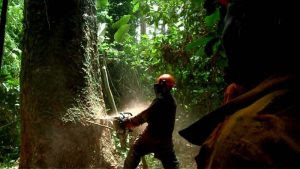THEY STOLE MERBAU TIMBER BEFORE OIL PALM PLANTATIONS INVESTMENT (PART 1)
Jan 16, 2018
Land clearing and timber logging activities in Keerom Regency, Papua Province – Dok. Jubi
Jayapura, Jubi – The largest land in Indonesia that has not been fully exploited is the forests and land of Papua.
Forest in Indonesia, from the study of Forest Wacht Indonesia in Sumatra and Borneo, has been used for plantation and transmigration, which largest areas are for oil palm plantations. Now the palm oil expansion is going to the eastern part of Indonesia, and Papua is the main target.
Indonesia pushed palm oil production by expanding the land used for plantations. No wonder that currently Indonesia has the largest oil palm plantation in the world. The total area are now reach is 16.1 million ha (Sawit Watch 2017) with income earned from this sector is over 200 Trillion rupiah
In 2017 this sector has contributed more than 18 billion USD or equivalent to the oil and gas sector which in the same period also generated about 18 billion USD. The high revenue from this sector has an impact on the governments incessant permit for investors, regardless the impact of the expansion.
Sawit Watch notes that the serious and most frequent impacts of oil palm expansion in Indonesia today are endless land conflicts. The absence of transparency in the licensing process and absence of clear and measurable plans for the sector have resulted in an easy access of permit for oil palm plantations in Indonesia today.
“The consequence of this conflict is criminalization of communities who defend their land, open up conflicts between communities and companies protected by security forces,” said Maryo Saputra, Head of Sawit Watch Campaign in a joint press conference with Walhi Papua in Jayapura end of the year.
Maryo who is in charge of Monitoring and observation in Sawit Watch said, Sumatra or Kalimantan has no longer become priority for oil palm plantation development. They have moved to Eastern Indonesia: Maluku, Sulawesi, West Papua and Papua. The process of land transferring, from forest and community livelihood (customs or local) to oil palm plantations is currently taking place, and one of them is in Papua Province.
Data from Sawit Watch show that oil palm plantation area in Papua Province has reach 958,094.2 ha with 79 plantation companies. The magnitude of the current extent has been an alarm for possibility of expansion grows in the year to come.
The expansion of further oil palm plantations according to Maryo will continue to grow in Papua province, considering the area of forest is still quite large. He warned the local government to be careful in giving permission.
Currently, the impact of oil palm plantations has been seen in Papua. Started from land conflicts; loss of indigenous people’s livelihoods; community criminalization by the company; and the environmental impact such as floods or forest and land fires. All have become visible evidence we can read in various media today.
Indigenous land grabbing has been experienced by Papuans since the era of Forest Concessions Right (HPH) by companies in the 1980s to land clearing for oil palm plantations.
Land grabbing
The secretary of Yeresiam Gua tribe in Nabire Papua, Robertino Hanebora said that timber and timber companies have long taken their land without negotiating with them.
“The sacred territory and sago hamlets belonging to the traditional community of Yeresiam were also taken by the company,” he said.
Yue Yance, one of the indigenous Yeresiam residents of Kampung Sima, in Nabire Regency said that Sima village is located on the edge of the beach, while oil palm plantation is only limited to the sago hamlet beside Sima.
“Before the oil palm plantation existed, it becomes paradise for birds, there were peacocks, white and black, birds of Taon Taon, many more,” he said as he pointed toward the oil palm plantation. But now everything is cleared and changed into oil palm plantations, birds fly away to look for forests and other places for shelter and foraging.
Sima in Nabire is only one ezample. Similar case also happens in Mimika Regency. Timika Bishop, Mgr. John Philip Saklil, Pr, has requested local governments to be firm against the operation of oil palm plantations. The bishop said palm oil company such as PT. Pusaka Agro Lestari (PAL), which has been operating in Mimika Regency, Papua since 2011, had threatens the lives of Kamoro people in Mimika Regency who live in lowland coastal areas.
“The impact of environmental damage has been quite large. This will be a serious threat to coastal residents,” the Bishop John told Jubi.
He also said the expansion of oil palm plantation area operated by PT. PAL is still continue, since they had pocketed permit of Right to Use (HGU) to open a land area of 38.000 hectare.
“It can deplete the forests and trees in Timika region. A big flood in the village of Miyoko and Aikawapuka was the proof; PT. PAL should take responsibility for the disaster,” the bishop said.(to be continued)
----------------------------

No comments:
Post a Comment
Note: Only a member of this blog may post a comment.